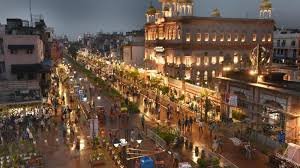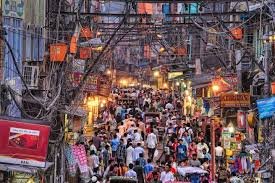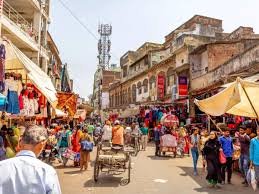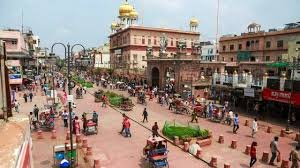

Chandni Chowk – The Heart of Old Delhi
If Delhi is the soul of India, then Chandni Chowk is the heartbeat that has been pulsating with life, culture, and commerce for over three centuries. Located in the walled city of Old Delhi, Chandni Chowk is one of the oldest and busiest markets in India, a place where history blends seamlessly with modern-day hustle. From Mughal-era architecture to mouth-watering street food, from wholesale markets to heritage havelis.
History of Chandni Chowk
Chandni Chowk was established in the 17th century by Mughal Emperor Shah Jahan when he shifted his capital from Agra to Shahjahanabad (Old Delhi). Designed by his daughter Jahanara Begum, the market was originally divided into canals that reflected the moonlight, giving it the name “Chandni” (moonlight) and “Chowk” (square). In its prime, Chandni Chowk was a hub for traders from across Asia, dealing in silk, spices, and precious stones.
Even today, walking through the lanes of Chandni Chowk feels like stepping into a living museum where each corner tells a story of royal processions, cultural exchanges, and centuries-old traditions.
How to Reach Chandni Chowk
Reaching Chandni Chowk is quite easy thanks to Delhi’s excellent connectivity:
-
- By Metro: The Chandni Chowk Metro Station (Yellow Line) drops you right at the market.
-
- By Road: You can take a cycle rickshaw, auto, or cab from anywhere in Delhi.
-
- By Walking Tour: Many heritage walks in Old Delhi begin from Chandni Chowk.
Tip: The streets are always bustling, so walking or taking a rickshaw is often the best way to explore.
Best Time to Visit Chandni Chowk
While Chandni Chowk is open all year round, the best time to visit is between October and March, when the weather is pleasant. The market usually opens around 10:00 AM and stays alive until 8:00 PM, except on Sundays when most shops are closed.
Things to Do in Chandni Chowk
1. Shopping in Chandni Chowk
Chandni Chowk is divided into multiple bazaars, each specializing in a specific category:
-
- Dariba Kalan: Famous for silver jewelry and gems.
-
- Kinari Bazaar: Bridal wear, zari borders, and decorative items.
-
- Nai Sarak: A paradise for book lovers and stationery shoppers.
-
- Chawri Bazaar: Known for wedding cards and brass products.
-
- Khari Baoli: Asia’s largest spice market, bursting with aromas of turmeric, saffron, and cardamom.
-
- Bhagirath Palace: Electronics and lighting solutions at wholesale prices.
2. Street Food
A trip to Chandni Chowk is incomplete without indulging in its legendary street food. The culinary heritage here dates back to the Mughal period.
-
- Paranthe Wali Gali: Famous for stuffed parathas served with chutney, pickle, and curry.
-
- Karim’s: Serving authentic Mughlai dishes like kebabs, mutton korma, and biryani.
-
- Jalebi Wala: Iconic shop for hot, syrupy jalebis.
-
- Natraj Dahi Bhalle: Known for creamy dahi bhallas and crispy aloo tikkis.
-
- Ghantewala Halwai: One of the oldest sweet shops in India.
Every bite in Chandni Chowk is an explosion of flavors and history.
3. Heritage Sites in Chandni Chowk
Chandni Chowk is not just a market but also home to some of Delhi’s most iconic landmarks:
-
- Red Fort: A UNESCO World Heritage site, just a short walk away.
-
- Jama Masjid: One of the largest mosques in India, built by Shah Jahan.
-
- Sis Ganj Gurudwara: Historic Sikh shrine honoring Guru Tegh Bahadur.
-
- Sri Digambar Jain Lal Mandir: Famous Jain temple with a bird hospital.
-
- Fatehpuri Masjid: Built by one of Shah Jahan’s wives, at the western end of Chandni Chowk.
Photography in Chandni Chowk
The bustling streets, colorful shops, vintage signboards, and heritage buildings make Chandni Chowk a photographer’s paradise. Whether you’re into street photography, food photography, or architectural shots, there’s something for every lens.
Travel Tips for Chandni Chowk
-
- Wear comfortable shoes; you’ll be walking a lot.
-
- Keep cash handy; some shops may not accept cards.
-
- Visit in the morning to avoid peak crowds.
-
- Beware of pickpockets in crowded areas.
-
- Don’t miss trying at least one street food dish.
Why Chandni Chowk is a Must-Visit
What makes Chandni Chowk so special is its ability to offer a sensory overload—aromas of freshly ground spices, the glint of gold jewelry, the chatter of bargaining shoppers, and the taste of authentic Delhi cuisine. It’s a place where you can shop for a bridal lehenga, eat a royal Mughlai feast, and visit centuries-old monuments—all in one afternoon.
Nearby Attractions
After exploring Chandni Chowk, you can visit:
-
- Raj Ghat: Memorial to Mahatma Gandhi.
-
- Meena Bazaar: Historic market near Red Fort.
-
- Chawri Bazaar: Bustling market for paper products.
-
- Kashmere Gate: Gateway to the historic city.
-
A Walk Back in Time – The Origin Story
In the 17th century, Emperor Shah Jahan moved his capital from Agra to a new city he named Shahjahanabad. Alongside the iconic Red Fort and Jama Masjid, his daughter Jahanara Begum designed a central bazaar that would serve both as a marketplace and a cultural meeting point.
Originally, a canal flowed through the middle, reflecting the light of the moon at night — a design feature that gave the place its poetic name. Traders from Central Asia, Persia, and across the Indian subcontinent flocked here with silks, spices, gems, and perfumes, making it one of the most significant trading centers in Asia.
-
A Food Lover’s Heaven
No visit to this part of Delhi is complete without sampling its culinary offerings. Centuries of Mughal influence, combined with Delhi’s diverse communities, have created a food culture that is both rich and irresistible.
-
Paranthe Wali Gali: An entire street dedicated to stuffed parathas served with chutneys and pickles.
-
Karim’s: A legendary eatery famous for kebabs, mutton korma, and biryani.
-
Jalebi Wala: Serving thick, syrupy jalebis that melt in your mouth.
-
Natraj Dahi Bhalle: Known for dahi bhallas and aloo tikkis.
-
Ghantewala Halwai: One of India’s oldest sweet shops, with recipes passed down through generations.
Whether you’re a vegetarian or a meat lover, there’s something here to satisfy every craving.
Architectural & Cultural Landmarks
Surrounding the marketplace are some of Delhi’s most iconic heritage sites:
-
Red Fort: Built in 1648, this UNESCO World Heritage Site is a symbol of Mughal grandeur.
-
Jama Masjid: One of the largest mosques in India, with stunning views of the city from its minarets.
-
Sis Ganj Gurudwara: A sacred Sikh site honoring Guru Tegh Bahadur.
-
Sri Digambar Jain Lal Mandir: Known for its bird hospital and intricate architecture.
-
Fatehpuri Masjid: Located at the far end of the market, offering a peaceful retreat from the chaos.
These landmarks add a deeper layer of meaning to any visit, connecting you to the centuries-old stories of resilience, devotion, and artistry.
A Paradise for Photographer
-

